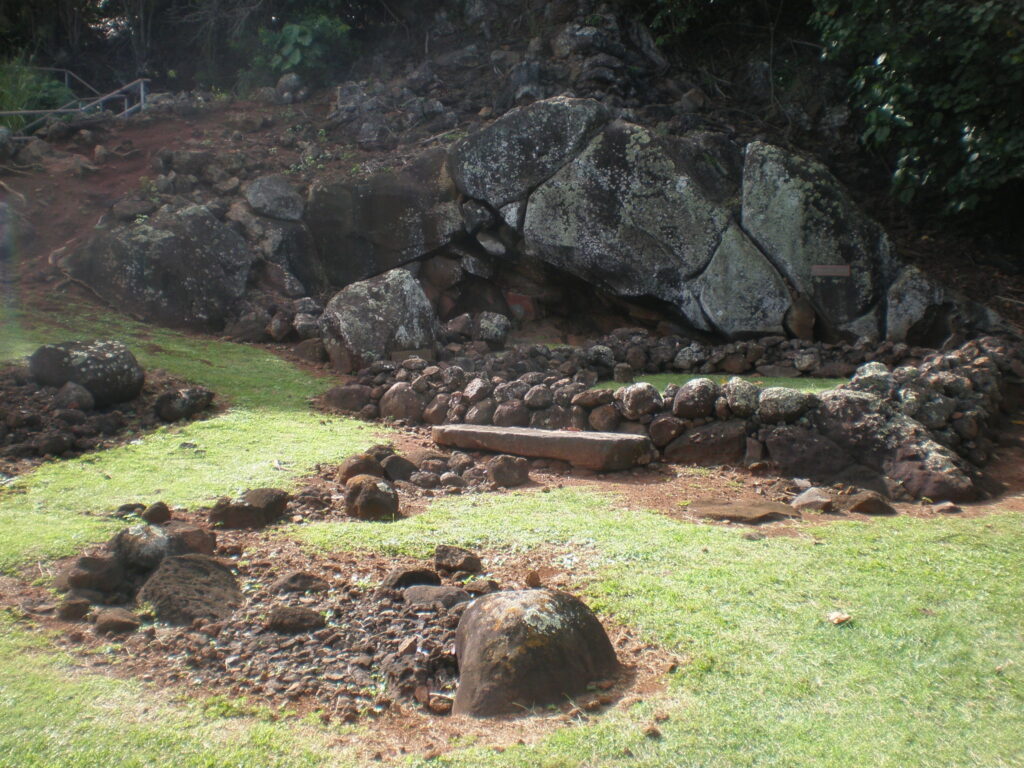Born at Haliʻimaile, Maui, Kahekilinui‘ahumanu (Kahekili) was the son of the high chief Kekaulike-kalani-ku‘i-hono-i-ka-moku (Kekaulike) and high chiefess Keku‘iapoiwanui-a-kalaninui-kaulele-ia-iwi.
Kalola (Kahekili’s sister and daughter of chief Kekaulike’s second wife) played an integral part in Kahekili’s reign over Maui Nui and O’ahu. Kalola, too, was a very high born ali’i.
In 1765, Kahekili inherited all of Maui Nui and O‘ahu and was appointed successor to his brother Kamehamehanui’s kingdom (not to be confused with Hawai‘i Island’s Kamehameha I.)
The power, however, that he received through this inheritance did not satisfy his desire to gain political influence through his own accomplishments. Therefore, Kahekili chose to prove himself through warfare.
He was a formidable competitor and demanded his warriors follow his lead, which they did. And, with each success, Kahekili’s power increased.
Kahekili first proved himself a formidable adversary by defeating the Hawaiʻi army led by Kalani‘ōpu‘u in 1775. Kalani‘ōpu‘u promised revenge and, in 1776, he again went to battle against Kahekili. Unfortunately, Kalaniʻōpuʻu was not aware of the alliance between Kahekili and Kahahana, an ali‘i of O‘ahu.
This alliance greatly outnumbered Kalaniʻōpuʻu’s army. Therefore, Kahekili and Kahahana’s army defeated Kalaniʻōpuʻu’s army as they entered the sand hills of Wailuku. This battle became known as Ahulau-ka-piʻipiʻi-i-kakanilua.
In a desperate act to save what was left, Kalani‘ōpu‘u requested that his wife, Kalola, plead for peace from her brother Kahekili.
However, knowing that Kahekili would not look upon her with favor, Kalola suggested their son, Kiwalaʻō be sent instead. Kahekili’s welcomed Kiwalaʻō and sealed his acceptance of peace.
For a time, after the great sand hills battle in Wailuku, peace and tranquility returned. Kahekili took his leadership seriously; he was faithful to his people, made changes, established rules and took active interest in the welfare of his people and lands.
During times of peace and celebration, when tournaments that required great strength, stamina and ability were held, Kahekili continued to amass great respect with his victories. Such victories assisted in further cementing his position as the son of the divine ruling family of Maui.
Later, Kahekili and his eldest son and heir-apparent, Kalanikūpule, were carrying on war and conquered Kahahana, adding Oʻahu under his control.
Through subsequent inter-island conquest, the marriage of his brother to the Queen of Kauaʻi, and appointment of his son to alternately govern Maui, Lānaʻi, Kahoʻolawe and Oʻahu during his periodic absences, by 1783, Kahekili dominated all the Hawaiian Islands, except for Hawaiʻi.
In the late-1780s into 1790, Kamehameha conquered the Island of Hawai‘i and was pursuing conquest of Maui and eventually sought to conquer the rest of the archipelago.
In 1790, Kamehameha travelled to Maui. Hearing this, Kahekili sent Kalanikūpule back to Maui with a number of chiefs (Kahekili remained on O‘ahu to maintain order there.)
Kahekili’s rule stretched for almost thirty years. He became known for his extreme measures whether it was making sure his people were obeying the kapu and the gods, or by destroying his enemies.
He ruled on Maui before he fell ill and returned to Waikīkī, until his death in 1793 at the age of eighty-seven. As with all ali‘i, Kahekili’s bones were carried away and hidden – thought to be in North Kohala.
Kahekili’s son, Kalanikūpule, inherited his kingdom. Kamehameha faced Kalanikūpule in the famous battle “Kepaniwai” (the damming of the waters) in ‘Iao Valley (which Kamehameha decisively won.)
Maui Island was conquered by Kamehameha and Maui’s fighting force was destroyed – Kalanikūpule and other chiefs escaped and made their way to O‘ahu (Kalanikūpule was later defeated by Kamehameha at the Battle of Nuʻuanu in 1795.)
(Lots of good information here is from “Kahekilinuiʻahumanu – Kahekili Study Guide” (Kauahea Inc and Maui Arts & Cultural Center.)) Image of Kahekili is by Brook Parker.



































